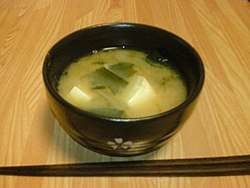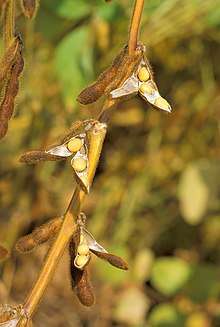Miso soup
 | |
| Type | Soup |
|---|---|
| Place of origin | Japan |
| Serving temperature | Hot |
| Main ingredients | stock (dashi), miso paste |
| Similar dishes | Doenjang-guk, doenjang-jjigae |
Miso soup (味噌汁 misoshiru) is a traditional Japanese soup consisting of a stock called "dashi" into which softened miso paste is mixed. Many ingredients are added depending on regional and seasonal recipes, and personal preference.
Miso soup is one of the two basic soup types of Japanese cuisine – the other one is suimono (clear soup).
Miso paste
The choice of miso paste for the miso soup defines a great deal of its character and flavor. Miso pastes (a traditional Japanese seasoning produced by fermenting soybeans with salt and the fungus Aspergillus oryzae, known in Japanese as kōjikin (麹菌), and sometimes rice, barley, or other ingredients) can be categorized into red (akamiso), white (shiromiso), or mixed (awase). There are many variations within these themes, including regional variations, such as Shinshū miso or Sendai miso.
A miso paste that has been fermented for a longer period of time, such as a red miso, gives the miso soup a stronger, deeper flavor. A miso paste that has been fermented for a shorter period of time, such as a white miso, provides a lighter, sweeter flavor.
More than 80% of Japan's total annual production of miso goes into miso soup, and 75% of all Japanese people consume miso soup at least once a day.[1]
Fermentation process
Miso, called fermented soybean paste, is now a popular food worldwide by a new processing system alongside the traditional fermented mechanism. In miso preparation, Aspergillus oryzae, grown on rice is known as rice-koji, is important as a starter for miso fermentation because of its prominent hydrolytic enzyme activities (Marui et al. 2013)[2]. In Japan, A. oryzae is widely used in the preparation of various traditional fermented foods such as rice wine, soy sauce, and miso paste because of its strong proteolytic activity and sugar utilization (Inoue et al. 2009)[3].
Miso preparation involves soybeans, rice, salt, water, and Aspergillus oryzae (rice-koji). The first step of miso preparation is inoculating rice or barley in shallow trays with strains of Aspergillus oryzae (Ahlburg) (O’ Toole, 2004)[4]. The carbohydrates are cooked for around 40 minutes and the soybeans are soaked and cooked at 115 °C for 20 minutes. Then, the Aspergillus oryzae mold culture is developed and grown abundantly on the cooked rice or barley. When the steamed rice is molded and mixed with A. oryzae, a fermented product forms-- koji. In the process of koji making, amylases and proteases are produced by the A. oryzae (koji mold) which help to break down the carbohydrates and proteins in wheat and soybean (Chancharoonpong et al, 2012)[5]. Meanwhile, soybeans are prepared by soaking in water and cooking for the fermentation. When the soybeans are fermented, they are mixed with the koji and proper amount of salt. After the mixture, the materials are properly packed in sealed container to undergo longer fermentation time. The room temperature is usually set between 30-35℃. The aged miso is then blended, mashed, and pasteurized.
The effect of temperature on miso texture:
The texture of miso is crucial in its digestibility. In order to obtain a more suitable texture and consistency, the temperature and preparation time must be controlled. The longer the cooking time at the common consistent temperature of 100°C (Nikkuni)[6], the softer the soybeans are, and the more suitable those beans are for the fermentation of quality miso. However, protein denaturation due to prolonged periods of thermal processing will reduce the nutritional qualities of the product. For that purpose, generally a cooking time of 10 minutes at 100°C will be suitable in retention of the nutritional aspects.
The processes of miso fermentation and its effects to the sensation of miso:
After miso goes through a two step process (first creating the koji, then combining koji with the other components and the mixture is left to be enzymatically digested, fermented and aged), it is mixed with other ingredients. Then, the material is packed into proper containers which allows it to undergo the lengthy fermentation process at room temperature (35°C). This goes on for several weeks until it is ground to a paste and packaged.
The effect of the intermediate process on miso taste:
Fermentation time also plays a large factor in the taste of miso. Paste that has been fermented for a long period of time, such as red miso, gives the prepared soup a stronger and deeper flavor. In contrast, miso paste that has been fermented for a short period of time, like white miso, often provides a lighter and sweeter flavor.
How length of ripening affects taste of miso
In the study done by Ogasawara, Yamada, & Egi, 2006, it was found that the taste and mouthfulness is a function of time due to the continued Maillard reaction amongst the peptides and sugars.Within this study the sensory taste profile as measured in time intervals from 10 days to 20 months at 10 days the taste was not typical miso a beany flavour the taste of traditional miso is no developed till 11 months. At 20 months the taste has continuity and mouthfulness and more intense taste.
After 11 months the taste of the miso was the same, but this study found that a better quality flavour can be achieved with continued ripening stating that 20 months had a more intense taste and mouthfulness. In this study it was found that the protein and polysaccharide hydrolyses remained constant after 3-5 months but through the visual analysis it can be seen that the Maillard reaction is continually occurring, as seen in the continued darkening of the miso paste with continued time. The conclusion of this study is that a longer ripening period will result in a better, more mouthful, and intense taste due to the continued Maillard reaction (Ogasawara et al., 2006)[7].
Stock
The most common dashi soup stocks for miso soup are made of niboshi (dried baby sardines), kombu (dried kelp), katsuobushi (thin shavings of dried and smoked bonito, aka skipjack tuna), or hoshi-shiitake (dried shiitake). The kombu can also be used in combination with katsuobushi or hoshi-shiitake. The kelp and/or shiitake dashi serve as a vegetarian soup stock.
Outside Japan, American or European style miso soup is sometimes made by dissolving miso in a Western vegetable stock. The stock might include ingredients such as negi, carrot, potato and daikon radish. In some versions of the dish chicken stock, Western-style fish stock, and other non-dashi bases can even be used, but there is some debate over whether or not miso soups made using these non-traditional bases count as true misoshiru. Christian Japanese refugees who came to the Philippines during the Edo period brought along miso soup.
Solid ingredients
According to Japanese custom, the solid ingredients are chosen to reflect the seasons and to provide contrasts of color, texture, and flavor. Thus negi and tofu, a strongly flavored ingredient mixed with a delicately flavored ingredient, are often combined. Ingredients that float, such as wakame seaweed, and ingredients that sink, such as potatoes, are also combined. Ingredients may include mushrooms, potatoes, seaweed, onion, shrimp, fish, clams, and sliced daikon. Nearly any Japanese ingredient is added to some type of misoshiru. However, misoshiru does not typically contain many ingredients beyond the stock and miso.
If pork is added to miso soup, it is called tonjiru, meaning "pork soup".
Preparation and serving
Miso soup can be prepared in several ways, depending on the chef and the style of soup. Japanese recipes usually call for most vegetables and meats to be cooked in the simmering dashi, particularly mushrooms, daikon, carrots, potatoes, tofu, and fish. The miso is suspended separately in some dashi stock removed from the simmering mix, to keep the miso paste from cooking, which alters the flavour, kills beneficial bacteria, and reduces the health benefits of biologically active miso paste. When the vegetables are cooked, the stock is removed from heat, the miso suspension is added and mixed into the soup, any uncooked ingredients are added, and the dish is served.
In Japan, miso soup and white rice make up the central dishes of the traditional Japanese breakfast. The soup has been a favorite of commoners and royalty alike for many centuries, but there are also many other dishes involving breakfast. They are all quite small, some include egg, fish, and nattō which is a fermented soy bean. The soup is usually served in lacquer bowls with lids and drunk directly from the bowl, though the solid ingredients are eaten with chopsticks. The bowl sometimes has a lid to keep heat and aroma in as well as to improve the presentation.[8]
Instant miso soup
Instant miso soup is available in single-serving packets. It is sold in dehydrated powder and paste forms. It generally contains dried toppings such as wakame and tofu with soy beans that reconstitute rapidly on the addition of hot water. These are popular in the Japanese workplace, where miso soup can be made with lunch as easily as green tea and using the same water. Instant miso soup is available in many grocery stores outside Japan. It has a shelf life of 3 to 12 months.
Wappani
Wappani (wappani (わっぱ煮) is a miso-soup-based dish unique to Awashima island off the coast of Niigata, Japan. A cedar flask ("wappa") is filled with miso soup, fish and vegetables and it is heated by dropping in hot rocks, which quickly bring it to a simmer. Hot rocks retain their heat for hours after being taken from the fire, so a hot meal can be prepared without the use of fire.
Health benefits
In 2003, researchers at Japan's National Cancer Centre suggested that "eating three or more bowls of the Japanese delicacy Miso soup every day could cut women's risk of developing breast cancer".[9] Miso soups also tend to be low in calories, but are filling because of the high protein content.
See also
References
- ↑ Shurtleff, William; Aoyagi, Akiko (2001). The Book of Tofu & Miso. Ten Speed Press. ISBN 1-58008-358-7.
- ↑ "Reduction of the degradation activity of umami-enhancing purinic ribonucleotide supplement in miso by the targeted suppression of acid phosphatases in the Aspergillus oryzae starter culture". International Journal of Food Microbiology. 166 (2): 238–243. 2013-09-02. doi:10.1016/j.ijfoodmicro.2013.07.006. ISSN 0168-1605.
- ↑ "Release of antihypertensive peptides in miso paste during its fermentation, by the addition of casein". Journal of Bioscience and Bioengineering. 108 (2): 111–115. 2009-08-01. doi:10.1016/j.jbiosc.2009.03.007. ISSN 1389-1723.
- ↑ "SOYBEAN | Soy-Based Fermented Foods". 2004-01-01: 174–185. doi:10.1016/B0-12-765490-9/00153-1.
- ↑ "Enzyme Production and Growth of Aspergillus oryzae S. on Soybean Koji Fermentation". APCBEE Procedia. 2: 57–61. 2012-01-01. doi:10.1016/j.apcbee.2012.06.011. ISSN 2212-6708.
- ↑ NIKKUNI, S.AYUKI; OKADA, N.ORIYUKI; ITOH, H.IROSHI (1988-03). "Effect of Soybean Cooking Temperature on the Texture and Protein Digestibility of Miso". Journal of Food Science. 53 (2): 445–449. doi:10.1111/j.1365-2621.1988.tb07727.x. ISSN 0022-1147. Check date values in:
|date=(help) - ↑ Ogasawara, Masashi; Yamada, Yuki; Egi, Makoto (2006-01). "Taste enhancer from the long-term ripening of miso (soybean paste)". Food Chemistry. 99 (4): 736–741. doi:10.1016/j.foodchem.2005.08.051. ISSN 0308-8146. Check date values in:
|date=(help) - ↑ Matsune, Kaz (21 October 2016). "Why Is Miso Soup Sometimes Served With a Lid?". Slate. Retrieved 21 October 2016.
- ↑ BBC News – June 2003 – Miso soup 'cuts breast cancer risk'
